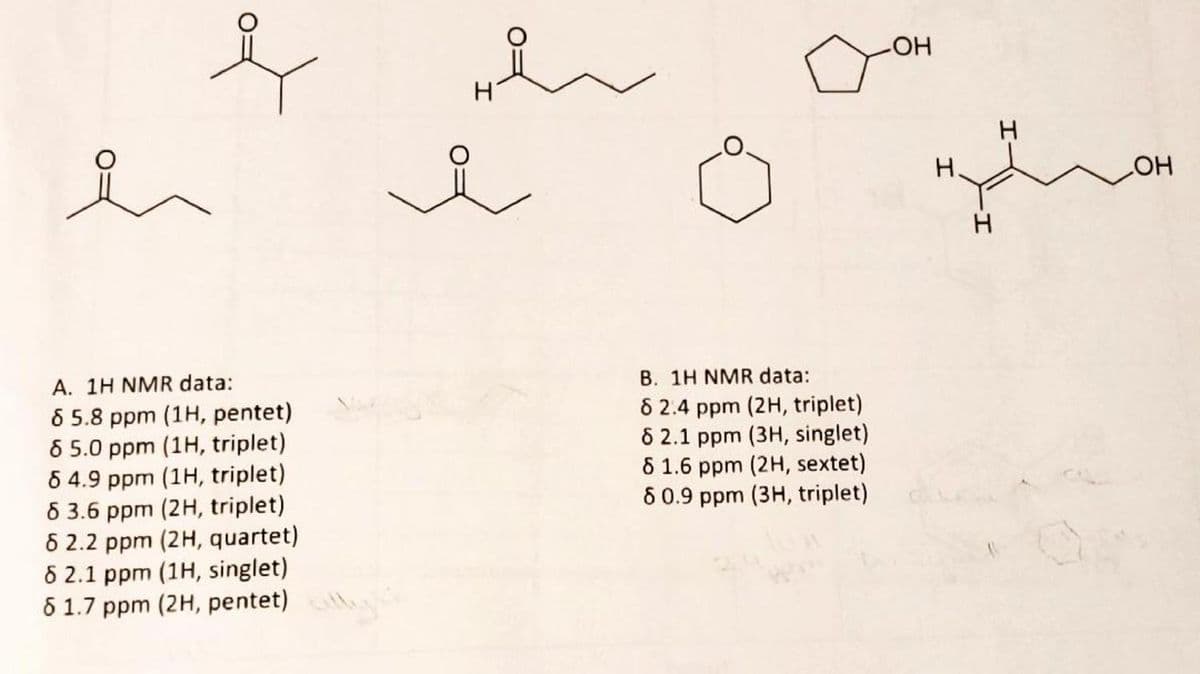i A. 1H NMR data: 8 5.8 ppm (1H, pentet) 8 5.0 ppm (1H, triplet) 8 4.9 ppm (1H, triplet) 8 3.6 ppm (2H, triplet) 8 2.2 ppm (2H, quartet) 8 2.1 ppm (1H, singlet) 8 1.7 ppm (2H, pentet) e i B. 1H NMR data: 8 2.4 ppm (2H, triplet) 82.1 ppm (3H, singlet) 8 1.6 ppm (2H, sextet) 8 0.9 ppm (3H, triplet) -OH H. H H OH
i A. 1H NMR data: 8 5.8 ppm (1H, pentet) 8 5.0 ppm (1H, triplet) 8 4.9 ppm (1H, triplet) 8 3.6 ppm (2H, triplet) 8 2.2 ppm (2H, quartet) 8 2.1 ppm (1H, singlet) 8 1.7 ppm (2H, pentet) e i B. 1H NMR data: 8 2.4 ppm (2H, triplet) 82.1 ppm (3H, singlet) 8 1.6 ppm (2H, sextet) 8 0.9 ppm (3H, triplet) -OH H. H H OH
Chapter19: Aldehydes And Ketones: Nucleophilic Addition Reactions
Section19.SE: Something Extra
Problem 80AP: Compound B is isomeric with A (Problem 19-79) and shows an IR peak at 1715 cm-1. The 1H NMR spectrum...
Related questions
Question
100%
Determine the 2 molecules based on the 1H NMR data. Explain the key features that helped determine the 2 molecules.

Transcribed Image Text:e
er
A. 1H NMR data:
85.8 ppm (1H, pentet)
8 5.0 ppm (1H, triplet)
8 4.9 ppm (1H, triplet)
8 3.6 ppm (2H, triplet)
62.2 ppm (2H, quartet)
8 2.1 ppm (1H, singlet)
6 1.7 ppm (2H, pentet)
Hen
B. 1H NMR data:
8 2.4 ppm (2H, triplet)
8 2.1 ppm (3H, singlet)
8 1.6 ppm (2H, sextet)
80.9 ppm (3H, triplet)
-OH
H.
H
LOH
Expert Solution
This question has been solved!
Explore an expertly crafted, step-by-step solution for a thorough understanding of key concepts.
This is a popular solution!
Trending now
This is a popular solution!
Step by step
Solved in 3 steps with 1 images

Knowledge Booster
Learn more about
Need a deep-dive on the concept behind this application? Look no further. Learn more about this topic, chemistry and related others by exploring similar questions and additional content below.Recommended textbooks for you

